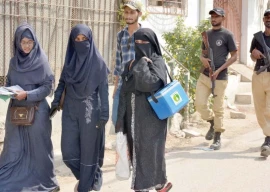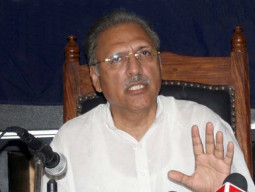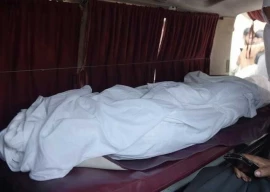
But for Kamran Asdar Ali, an associate professor of anthropology at the University of Texas, Austin, working in the US affords him a bird’s-eye view of the changes in his hometown, Karachi. Indeed, his work has long been preoccupied with cities: He is the author of Planning the Family in Egypt, co-editor of Gendering Urban Space in the Middle East, South Asia and Africa and Comparing Cities: Middle East and South Asia, both with Martina Rieker, with whom he also coordinates the Shehr Network on Comparative Urban Landscapes.
Thus it was with a fresh eye that he took in the recent drive from the airport on to Sharah-e-Faisal. He was struck by the vast expanses of military land on both sides where more buildings had come up. The large houses near Nursery had been replaced with commercial towers.
“There are more flyovers and a lot of empty space underneath them,” he told The Express Tribune in an interview on Tuesday. “I also see a lot of huge buildings, which are not sustainable. There is seepage in the walls and they look ugly.”
Demographics
People don’t realise but different ethnicities have started to move around the city too, he said.
“Urdu-speaking people are moving from Gulshan-e-Iqbal to Clifton and Defence. Pathans and Punjabis have shifted to Paposh from Banaras and other places. This has altered the relations between neighbours.” There is nothing wrong with such demographic shifts, he stresses, but it is important for the city’s managers to ensure everyone enters mainstream city life instead of being relegated to its margins.
The city’s politics, which used to revolve around social status, has been replaced with that of ethnicity, Asdar says. “Waves of immigrants have come to Karachi from other cities and settled around industrial areas. Their lives start and end there.”
The key is how the majority is made to feel that the city belongs to them given that satisfying everyone is impossible. But people must realise that Karachi is part of the province, he says when asked to comment on the local government system that the Muttahida Qaumi Movement and the Pakistan Peoples Party are trying to hammer. “Because of its industries, the city generates most of the taxes, but all of them can’t be spent here,” he feels. “I personally believe Karachi will do well under a local government system with an elected mayor.”
Working on an assignment in Egypt in the 1990s, he came across men who lived on the fringes of Cairo and had never seen Tahrir Square – the central part of the city. “When I invited them for a meal, almost all of them wondered how they would reach the place?”
He also notes that for Karachi there is a lack of places where everyone can mingle, like Empress Market. This has led to a ghettoisation of neighbourhoods. “Now people who live in Hyderi will want to go out to eat in the same area. My nephews are scared of going to Saddar from Clifton.”
Before factories with their boilers and bank offices in glass towers came up, there were scattered villages around the city, he points out. “We must not forget that we have pushed them further and further into small ghettoes.”
Transport and housing
As with other sprawling cities, public transport problems have surfaced in Karachi as well.
“There are too many private cars,” Asdar notes. “Under Pervez Musharraf, the interest rate was lowered and car financing was doled out to everyone. Then, for all these cars, flyovers were built. However, for the average citizen, I see only more worries.”
A great challenge before the authorities is to provide the public affordable housing accommodation. “Letting private developers construct congested apartments is not the answer.” In the 1940s, for example, the government built flats for the poor in New York. But by the 1970s, they were being demolished because the places had become a hotbed for crime.
Across Karachi, large projects are facing similar problems, he says. “We must ask ourselves first if such structures are sustainable – whether we are able to keep the elevators running, if there is enough water and electricity.” He says he doesn’t necessarily have solutions for these kind of problems, but sometimes working towards one starts with realising that the status quo isn’t sustainable.
Published in The Express Tribune, January 18th, 2012.
COMMENTS (10)
Comments are moderated and generally will be posted if they are on-topic and not abusive.
For more information, please see our Comments FAQ

















@sonofsoil:
Karachi has always been Pakistan's biggest metropolis, people from all over the country migrate to it, and that's why most Mohajirs settled here - it should not be exclusive to any ethnicity and you should appreciate the diversity. Yes, the majority of the people of Karachi are Urdu-speaking who left everything they had to live here - and now this city contributes to 65% of the GDP, while the rest of the province suffers under feudal landlords. Stop making excuses because of you're a "son of the soil", so is anyone who is born in Karachi. If you really want to do something for Sindh, stop whining to us and tell the feudal fatcats in your villages to give your people their rights.
65 years down the lane, still not son of the soil. When will we grow out of this and be able to accept
“I personally believe Karachi will do well under a local government system with an elected mayor.”
100% agreed.... Both Naimatullah Khan and Mustufa Kamal worked very hard and changed the city many time, then their predecesors...
But some how the MQM does not want the LCG system, eventhough many of the people voted(in the last election) for the work they did as CDGK(also in Hyderabad)... If they are not supporting the system I dont think many of the new MQM voters(from the last elections) will vote again for them....
@Ahad, we don't want to be harassed again
@sonofsoil: Why the son of soil only worry about Karachi? There is almost always a "son of soil" as a chief minister but never tries to develop interior Sindh. Unfortunately, the other son of soils have no objection and will vote for him again.
We want Mustafa Kamal back !
@sonofsoil : stop saying karachi is stranger to you.. the day you start to own karachi like every karachites do.. karachi will feel no stranger to you.. stop making us feel like as if we stole your city from you.. always remember, karachi had nothing until we settled into it.. it was nothing until we started owning it.. every one tried to kick us out of here but we never gave up.. So stop whining and start doing something..
@sonofsoil I disagree with you there.Urdu speaking and sindhi speaking pupils are more compatible and comfortable with each other as compared to any other ethnicity.Hundreds of thousand of sindhis are living in karachi.I know many.Please consider them while making such statements.
Karachi is for every one but Sindhi. Our city is made stranger to sons of soil. What a bounties of Freedom and partition!